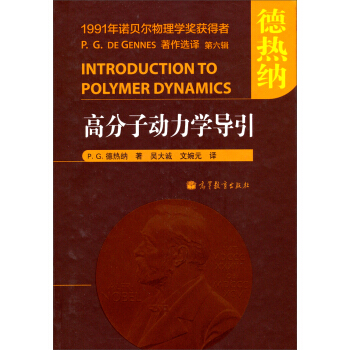

具体描述
内容简介
《生物数学·第1卷(第3版)》是近代生物数学方面的名著。这是第一卷,第三版,在原来版本的基础上做了全面修订。近年来这个科目的茁壮成长和新知识点的不断涌现,新的版本将原来的一卷集分成上下两卷,扩大了知识容量,第二卷绝大多数是新增知识点。书中对生物学中的反应扩散方程和形态发生学的数学理论及研究成果作了全面介绍,是学习与研究生物数学的一部不可多得的参考书。目录
contents, volume ipreface to the third edition
preface to the first edition
1. continuous population models for single species
1.1 continuous growth models
1.2 insect outbreak model: spruce budworm
1.3 delay models
1.4 linear analysis of delay population models: periodic solutions
1.5 delay models in physiology: periodic dynamic diseases
1.6 harvesting a single natural population
1.7 population model with age distribution
exercises
2. discrete population models for a single species
2.1 introduction: simple models
2.2 cobwebbing: a graphical procedure of solution
2.3 discrete logistic-type model: chaos
2.4 stability, periodic solutions and bifurcations
2.5 discrete delay models
2.6 fishery management model
.2.7 ecological implications and caveats
2.8 tumour cell growth
exercises
3. models for interacting populations
3.1 predator-prey models: lotka-volterra systems
3.2 complexity and stability
3.3 realistic predator-prey models
3.4 analysis of a predator-prey model with limit cycle periodic behaviour: parameter domains of stability
3.5 competition models: competitive exclusion principle
3.6 mutualism or symbiosis
3.7 general models and cautionary remarks
3.8 threshold phenomena
3.9 discrete growth models for interacting populations
3.10 predator-prey models: detailed analysis
exercises
4. temperature-dependent sex determination (tsd)
4.1 biological introduction and historical asides on the crocodilia.
4.2 nesting assumptions and simple population model
4.3 age-structured population model for crocodilia
4.4 density-dependent age-structured model equations
4.5 stability of the female population in wet marsh region l
4.6 sex ratio and survivorship
4.7 temperature-dependent sex determination (tsd) versus genetic sex determination (gsd)
4.8 related aspects on sex determination
exercise
5. modelling the dynamics of marital interaction: divorce prediction and marriage repair
5.1 psychological background and data: gottman and levenson methodology
5.2 marital typology and modelling motivation
5.3 modelling strategy and the model equations
5.4 steady states and stability
5.5 practical results from the model
5.6 benefits, implications and marriage repair scenarios
6. reaction kinetics
6.1 enzyme kinetics: basic enzyme reaction
6.2 transient time estimates and nondimensionalisation
6.3 michaelis-menten quasi-steady state analysis
6.4 suicide substrate kinetics
6.5 cooperative phenomena
6.6 autocatalysis, activation and inhibition
6.7 multiple steady states, mushrooms and isolas
exercises
7. biological oscillators and switches
7.1 motivation, brief history and background
7.2 feedback control mechanisms
7.3 oscillators and switches with two or more species: general qualitative results
7.4 simple two-species oscillators: parameter domain determination for oscillations
7.5 hodgkin-huxley theory of nerve membranes:fitzhugh-nagumo model
7.6 modelling the control of testosterone secretion and chemical castration
exercises
8. bz oscillating reactions
8.1 belousov reaction and the field-koros-noyes (fkn) model
8.2 linear stability analysis of the fkn model and existence of limit cycle solutions
8.3 nonlocal stability of the fkn model
8.4 relaxation oscillators: approximation for the belousov-zhabotinskii reaction
8.5 analysis of a relaxation model for limit cycle oscillations in the belousov-zhabotinskii reaction
exercises
9. perturbed and coupled oscillators and black holes
9.1 phase resetting in oscillators
9.2 phase resetting curves
9.3 black holes
9.4 black holes in real biological oscillators
9.5 coupled oscillators: motivation and model system
9.6 phase locking of oscillations: synchronisation in fireflies
9.7 singular perturbation analysis: preliminary transformation
9.8 singular perturbation analysis: transformed system
9.9 singular perturbation analysis: two-time expansion
9.10 analysis of the phase shift equation and application to coupled belousov-zhabotinskii reactions
exercises
10. dynamics of infectious diseases
10.1 historical aside on epidemics
10.2 simple epidemic models and practical applications
10.3 modelling venereal diseases
10.4 multi-group model for gonorrhea and its control
10.5 aids: modelling the transmission dynamics of the human immunodeficiency virus (hiv)
10.6 hiv: modelling combination drug therapy
10.7 delay model for hiv infection with drug therapy
10.8 modelling the population dynamics of acquired immunity to parasite infection
10.9 age-dependent epidemic model and threshold criterion
10.10 simple drug use epidemic model and threshold analysis
10.11 bovine tuberculosis infection in badgers and caule
10.12 modelling control strategies for bovine tuberculosis in badgers and cattle
exercises
11. reaction diffusion, chemotaxis, and noniocal mechanisms
11.1 simple random walk and derivation of the diffusion equation
11.2 reaction diffusion equations
11.3 models for animal dispersal
11.4 chemotaxis
11.5 nonlocal effects and long range diffusion
11.6 cell potential and energy approach to diffusion and long range effects
exercises
12. oscillator-generated wave phenomena
12. i belousov-zhabotinskii reaction kinematic waves
12.2 central pattern generator: experimental facts in the swimming of fish
12.3 mathematical model for the central pattern generator
12.4 analysis of the phase coupled model system
exercises
13. biological waves: single-species models
13. l background and the travelling waveform
13.2 fisher-kolmogoroff equation and propagating wave solutions
13.3 asymptotic solution and stability of wavefront solutions of the fisher-kolmogoroff equation
13.4 density-dependent diffusion-reaction diffusion models and some exact solutions
13.5 waves in models with multi-steady state kinetics: spread and control of an insect population
13.6 calcium waves on amphibian eggs: activation waves on medaka eggs
13.7 invasion wavespeeds with dispersive variability
13.8 species invasion and range expansion
exercises
14. use and abuse of fractals
14.1 fractals: basic concepts and biological relevance
14.2 examples of fractals and their generation
14.3 fractal dimension: concepts and methods of calculation
14.4 fractals or space-filling?
appendices
a. phase plane analysis
b. routh-hurwitz conditions, jury conditions, descartes'
rule of signs, and exact solutions of a cubic
b.1 polynomials and conditions
b.2 descartes' rule of signs
b.3 roots of a general cubic polynomial
bibliography
index
contents, volume ii
j.d. murray: mathematical biology, ii: spatial models and biomedical applications
preface to the third edition
preface to the first edition
1. multi-species waves and practical applications
1.1 intuitive expectations
1.2 waves of pursuit and evasion in predator-prey systems
1.3 competition model for the spatial spread of the grey squirrel in britain
1.4 spread of genetically engineered organisms
1.5 travelling fronts in the belousov-zhabotinskii reaction
1.6 waves in excitable media
1.7 travelling wave trains in reaction diffusion systems with oscillatory kinetics
1.8 spiral waves
1.9 spiral wave solutions of x-co reaction diffusion systems
2. spatial pattern formation with reaction diffusion systems
2.1 role of pattern in biology
2.2 reaction diffusion (turing) mechanisms
2.3 general conditions for diffusion-driven instability:linear stability analysis and evolution of spatial pattern
2.4 detailed analysis of pattern initiation in a reaction diffusion mechanism
2.5 dispersion relation, turing space, scale and geometry effects in pattern formation models
2.6 mode selection and the dispersion relation
2.7 pattern generation with single-species models: spatial heterogeneity with the spruce budworm model
2.8 spatial patterns in scalar population interaction diffusion equations with convection: ecological control strategies
2.9 nonexistence of spatial patterns in reaction diffusion systems: general and particular results
3. animal coat patterns and other practical applications of reactiondiffusion mechanisms
3.1 mammalian coat patterns--'how the leopard got its spots'
3.2 teratologies: examples of animal coat pattern abnormalities
3.3 a pattern formation mechanism for butterfly wing patterns
3.4 modelling hair patterns in a whorl in acetabularia
4. pattern formation on growing domains: alligators and snakes
4. i stripe pattern formation in the alligator: experiments
4.2 modelling concepts: determining the time of stripe formation
4.3 stripes and shadow stripes on the alligator
4.4 spatial patterning of teeth primordia in the alligator:background and relevance
4.5 biology of tooth initiation
4.6 modelling tooth primordium initiation: background
4.7 model mechanism for alligator teeth patterning
4.8 results and comparison with experimental data
4.9 prediction experiments
4.10 concluding remarks on alligator tooth spatial patterning
4.11 pigmentation pattern formation on snakes
4.12 cell-chemotaxis model mechanism
4.13 simple and complex snake pattern elements
4.14 propagating pattern generation with the celi-chemotaxis system
5. bacterial patterns and chemotaxis
5.1 background and experimental results
5.2 model mechanism for e. coli in the semi-solid experiments
5.3 liquid phase model: intuitive analysis of pattern formation
5.4 interpretation of the analytical results and numerical solutions
5.5 semi-solid phase model mechanism for s. typhimurium
5.6 linear analysis of the basic semi-solid model
5.7 brief outline and results of the nonlinear analysis
5.8 simulation results, parameter spaces, basic patterns
5.9 numerical results with initial conditions from the experiments
5.10 swarm ring patterns with the semi-solid phase model mechanism
5.11 branching patterns in bacillus subtilis
6. mechanical theory for generating pattern and form in development
6.1 introduction, motivation and background biology
6.2 mechanical model for mesenchymal morphogenesis
6.3 linear analysis, dispersion relation and pattern formation potential
6.4 simple mechanical models which generate spatial patterns with complex dispersion relations
6.5 periodic patterns of feather germs
6.6 cartilage condensation in limb morphogenesis and morphogenetic rules
6.7 embryonic fingerprint formation
6.8 mechanochemical model for the epidermis
6.9 formation of microvilli
6.10 complex pattern formation and tissue interaction models
7. evolution, morphogenetic laws, developmental constraints and teratologies
7.1 evolution and morphogenesis
7.2 evolution and morphogenetic rules in cartilage formation in the vertebrate limb
7.3 teratologies (monsters)
7.4 developmental constraints, morphogenetic rules and the consequences for evolution
8.a mechanical theory of vascular network formation
8.1 biological background and motivation
8.2 cell-extracellular matrix interactions for vasculogenesis
8.3 parameter values
8.4 analysis of the model equations
8.5 network patterns: numerical simulations and conclusions
9. epidermal wound healing
9.1 brief history of wound healing
9.2 biological background: epidermal wounds
9.3 model for epidermal wound healing
9.4 nondimensional form, linear stability and parameter values
9.5 numerical solution for the epidermal wound repair model
9.6 travelling wave solutions for the epidermal model
9.7 clinical implications of the epidermal wound model
9.8 mechanisms of epidermal repair in embryos
9.9 actin alignment in embryonic wounds: a mechanical model
9.10 mechanical model with stress alignment of the actin filaments in two dimensions
10. dermal wound healing
10.1 background and motivation---general and biological
10.2 logic of wound healing and initial models
10.3 brief review of subsequent developments
10.4 model for fibroblast-driven wound healing: residual strain and tissue remodelling
10.5 solutions of the model equation solutions and comparison with experiment
10.6 wound healing model of cook (1995)
10.7 matrix secretion and degradation
10.8 cell movement in an oriented environment
10.9 model system for dermal wound healing with tissue structure
10.10 one-dimensional model for the structure of pathological scars
10.11 open problems in wound healing
10.12 concluding remarks on wound healing
11. growth and control of brain tumours
11.1 medical background
11.2 basic mathematical model of glioma growth and invasion
11.3 tumour spread in vitro: parameter estimation
11.4 tumour invasion in the rat brain
11.5 tumour invasion in the human brain
11.6 modelling treatment scenarios: general comments
11.7 modelling tumour resection (removal) in homogeneous tissue
11.8 analytical solution for tumour recurrence after resection
11.9 modelling surgical resection with brain tissue heterogeneity
11.10 modelling the effect of chemotherapy on tumour growth
11.11 modeling tumour polyclonality and cell mutation
12. neural models of pattern formation
12.1 spatial patterning in neural firing with a simple activation-inhibition model
12.2 a mcchanism for stripe formation in the visual cortex
12.3 a model for the brain mechanism underlying visual hallucination patterns
12.4 neural activity model for shell patterns
12.5 shamanism and rock art
13. geographic spread and control of epidemics
13.1 simple model for the spatial spread of an epidemic
13.2 spread of the black death in europe 1347-1350
13.3 brief history of rabies: facts and myths
13.4 the spatial spread of rabies among foxes i: background and simple model
13.5 spatial spread of rabies among foxes ii:three-species (sir) model
13.6 control strategy based on wave propagation into a non-epidemic region: estimate of width of a rabies barrier
13.7 analytic approximation for the width of the rabies control break
13.8 two-dimensional epizootic fronts and effects ot variable fox densitics: quantitative predictions for a rabies outbreak in england
13.9 effect of fox immunity on spatial spread of rabies
14. wolf territoriality, wolf-deer interaction and survival
14.1 introduction and wolf ecology
14.2 models for wolf pack territory formation: single pack--home range model
14.3 multi-wolf pack territorial model
14.4 wolf-deer predator-prey model
14.5 concluding remarks on-wolf territoriality and deer survival
14.6 coyote home range patterns
14.7 chippewa and sioux intertribal conflict c1750-1850
appendix
a. general results for the laplacian operator in bounded domains
bibliography
index
前言/序言
用户评价
这本《生物数学·第1卷》(第三版)的封面设计非常具有吸引力,我个人非常喜欢这种低调而又富有内涵的风格,它不像一些科普读物那样花哨,而是透露出一种扎实的学术底蕴。我对书中可能涉及的数学方法在解决生物学难题中的具体应用非常感兴趣。例如,如何利用数学模型来模拟基因调控网络,或者预测蛋白质折叠过程。我知道,生物学研究越来越依赖于定量分析和计算能力,而一本好的生物数学教材,应该能够为读者提供必要的工具和思维方式。我希望这本书不仅能教会我数学公式,更能教会我如何“用数学的眼睛”去看待生物学问题,从而提出更具创新性的研究思路。
评分这本书的装帧非常精美,封面设计简洁大气,采用了深邃的蓝色作为主色调,搭配烫金的“生物数学·第1卷”字样,散发出一种严谨而富有学术气息的质感。翻开书页,纸张的触感细腻而富有弹性,印刷清晰,字体大小适中,即使长时间阅读也不会感到疲劳。在内容呈现上,作者似乎非常注重知识体系的构建,从目录的设计就能看出其条理性和系统性。虽然我还没有深入阅读,但单从其编排结构来看,它似乎能为读者提供一个扎实的生物数学入门框架。我尤其期待书中对数学工具在生物学问题中应用的部分,例如模型构建、数据分析等方面,相信它能为我理解复杂的生物现象提供新的视角和强大的解析工具。这是一种能够激发人探索欲望的学术著作,迫不及待想进入书中的世界,去解锁那些隐藏在数字背后的生命奥秘。
评分这本书给我的第一印象是其厚重感,从书脊和页数来看,它无疑是一部内容翔实的著作。作为一名正在学习生物学相关专业的学生,我对生物数学的理解还停留在比较基础的层面,很多时候会因为数学工具的欠缺而感到学习上的瓶颈。这本书恰好填补了我在这方面的需求。我特别期待它能清晰地讲解一些生物学中常用的数学模型,例如Lotka-Volterra模型在捕食者-猎物关系中的应用,或者ODE和PDE在描述生物过程中的作用。同时,我也希望书中能够提供一些实际操作的指导,比如如何利用编程语言(如Python或R)来实现这些模型,从而进行仿真和数据分析。
评分作为一个长期关注生物科学前沿动态的业余爱好者,我一直希望能找到一本能够系统梳理和解释数学在生物领域扮演角色的书籍。这本书的名字《生物数学·第1卷》无疑正中下怀,而且是第三版,这通常意味着内容经过了多次打磨和更新,更加成熟和完善。我设想这本书会涵盖从基础的微分方程、概率论,到更复杂的动力学模型、统计推断等内容,并且会用生动的生物学案例来佐证这些数学理论的实际应用。想象一下,通过数学的语言来理解种群的动态演变,或者预测疾病的传播趋势,这本身就是一件令人兴奋的事情。我非常期待书中是否会涉及一些近年来新兴的生物数学分支,例如计算生物学、系统生物学等,它们正在深刻地改变我们对生命的认知方式。
评分这本书的名字本身就充满了科学的魅力,它将两个看似截然不同的学科——生物学和数学——巧妙地结合在一起。我一直认为,数学是理解自然界深层规律的钥匙,而生物学则是自然界中最复杂、最迷人的领域之一。这本书的出版,无疑为我们提供了一个绝佳的窗口,去探索生命现象背后隐藏的数学逻辑。我设想它会带领读者从细胞的微观世界,到生态系统的宏观格局,用数学的语言揭示生命的奥秘。我尤其希望能从书中学习到如何构建有效的数学模型来描述生物过程,并理解这些模型在预测和控制生物系统中的作用,这对于解决当前面临的许多生物学挑战,如疾病防治、环境保护等,都具有重要的意义。
评分不错的书。。。。。。
评分当今的生物数学仍处于探索和发展阶段,生物数学的许多方法和理论还很不完善,它的应用虽然取得某些成功,但仍是低水平的、粗略的、甚至是勉强的。许多更复杂的生物学问题至今未能找到相应的数学方法进行研究。因此,生物数学还要从生物学的需要和特点,探求新方法、新手段和新的理论体系,还有待发展和完善。618活动时候买的,价格实惠,感谢京东,以后买书就上这了。
评分还没看,先给个好评吧。物流也快。好评。
评分书是经典,印刷质量不错,。
评分知识是人类在实践中认识客观世界的成果。它可能包括事实,信息,描述或在教育和实践中获得的技能。它可能是关于理论的,也可能是关于实践的。在哲学中,关于知识的研究叫做认识论。知识的获取涉及到许多复杂的过程:感觉,交流,推理。知识也可以看成构成人类智慧的最根本的因素。
评分很有意思的
评分继托姆之后,跃变论不断地发展。例如塞曼又提出初级波和二级波的新理论。
评分是很好,内容很全,适合生物数学方向的研究生、博士生、教研员等收藏拜读。系统论和控制论是以系统和控制的观点,进行综合分析的数学方法。系统论和控制论的方法没有把那些次要的因素忽略,也没有孤立地看待每一个特性,而是通过状态方程把错综复杂的关系都结合在一起,在综合的水平上进行全面分析。对系统的综合分析也可以就系统的可控性、可观测性和稳定性作出判断,更进一步揭示该系统生命活动的特征。
评分是很好,内容很全,适合生物数学方向的研究生、博士生、教研员等收藏拜读。系统论和控制论是以系统和控制的观点,进行综合分析的数学方法。系统论和控制论的方法没有把那些次要的因素忽略,也没有孤立地看待每一个特性,而是通过状态方程把错综复杂的关系都结合在一起,在综合的水平上进行全面分析。对系统的综合分析也可以就系统的可控性、可观测性和稳定性作出判断,更进一步揭示该系统生命活动的特征。
相关图书
本站所有内容均为互联网搜索引擎提供的公开搜索信息,本站不存储任何数据与内容,任何内容与数据均与本站无关,如有需要请联系相关搜索引擎包括但不限于百度,google,bing,sogou 等,本站所有链接都为正版商品购买链接。
© 2025 windowsfront.com All Rights Reserved. 静流书站 版权所有




![有机化学(第4版)(下册)/高等学校教材 [Orgnic Chemistry] pdf epub mobi 电子书 下载](https://pic.windowsfront.com/11318855/564150deNb2e3db3f.jpg)









![EHS管理系列:环境安全管理体系理论与实践 [Environmental Safety Management System: Theory and Practice] pdf epub mobi 电子书 下载](https://pic.windowsfront.com/11462772/53868266Nf8a275d4.jpg)

![离散时间控制系统(第二版) [Discrete-Time Control Systems, Second Edition?] pdf epub mobi 电子书 下载](https://pic.windowsfront.com/11489732/53b141caNb8876a85.jpg)



